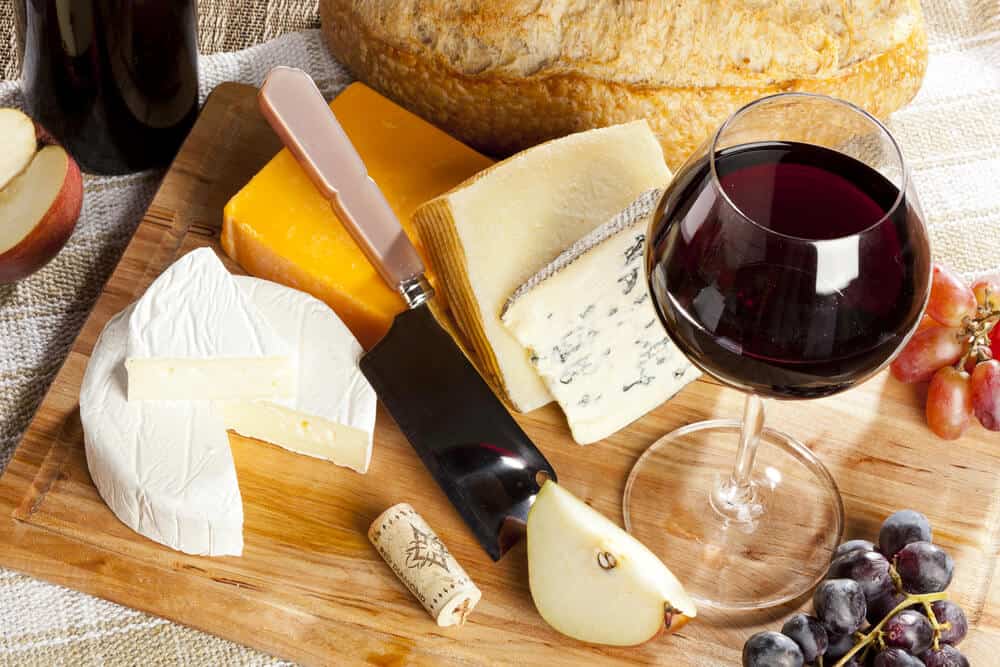Peanut butter and jelly. Cookies and milk. Whiskey and water. Age-old, timeless pairings. But there’s nothing that compares with the unbeatable combo of wine and cheese. People have been pairing wine and cheese since the two were invented. Even though the process may seem simple, it’s very easy to mess up. So we here at Ultra Wine Racks thought we’d write a little blog post and de-mystify the process for you.
First, let’s discuss the types of cheese. Then we can talk about the types of wine that pair best with certain types of cheese.
Types of Cheese
Cheese, as it turns out, is remarkably like wine. It’s made from a basic agricultural product (milk). It undergoes a process of fermentation. Many cheeses must mature before they can be properly enjoyed. A lot of cheese is named after the region in which it is traditionally made, too. And, also like wine, there are dozens of different types of cheeses. It’s not surprising that pairing wine and cheese can be a complicated business. So let’s start simple.
Cheeses come in three different textures: soft, semi-soft, and hard. Soft cheeses like Brie and Neufchâtel are soft and spreadable (perhaps even runny). Semi-soft cheeses like Havarti and Munster are moist and mild. Medium-hard cheeses like Gouda, Jarlsberg, Emmental, and Gruyère are often aromatic and “sharp” in flavor, good for slicing and pairing with bread and meat or for melting on toast. Semi-hard cheeses are less moist than medium-hard and soft cheeses, as they are packed into molds and aged under pressure for longer lengths of time. Cheddar, Gloucester, Colby, and Monterey Jack are semi-hard cheeses. Finally, hard cheeses such as Parmesan and Pecorino are packed into molds and aged for months, even years, giving them very low moisture content and making them difficult to slice (more often they are grated, or broken into shards). They tend to be nutty in flavor, and some are quite salty.
Cheese can be made from cow’s milk, sheep’s milk, or goat’s milk. (There’s even a farm in Sweden that makes moose-milk cheese, or so we’ve heard.) Many cheeses make use of benign, edible molds or yeasts to age them and improve their flavor.
Here are a couple of other cheese types you should be aware of:
Bloomy: So-called bloomy cheeses are soft and white and have a “bloom” of white mold on the outside. Brie is probably the most well-known bloomy cheese, but there are many different kinds. The edible rind has a stronger flavor than the cheese itself. The flavors of bloomy cheeses are comparable to onion or mushroom.
Blue: Blue (sometimes spelled “bleu”) cheese has streaks of blue mold running through it. Some blue cheeses are soft (creamy and even spreadable), others are semi-soft (crumbly). They can be sweet and mild or tart and power-packed, but all of them (thanks to the mold) will be tangy.
Fresh: Fresh cheeses are not aged. They tend to be mild in flavor, though they may have a sharp tang to them. Goat cheese, mozzarella, and ricotta cheese are two examples of “fresh” cheese.
Washed-rind: These cheeses, as they age, are occasionally dipped into a brine solution which may also include spices, brandy, wine, or beer. This makes their surfaces attractive to a certain type of bacteria (Brevibacterium linens). These bacteria imbue the cheese with unique odors and flavors. Washed-rind cheeses can be hard, semi-hard, or soft. Other cheeses may be smear-ripened (literally smeared with bacteria or fungi solutions) or soft-ripened (coated in mold and then aged from the outside in).
Pairing Wine and Cheese
Right, we’ve talked ourselves out about cheese! Now let’s get to the fun stuff: wine and cheese pairings.
- Fresh cheese pairs best with fruity reds (like pinot noir), rosé, and whites like sauvignon blanc and chardonnay. For saltier cheeses like feta, try riesling or gewürztraminer. Our suggested pairing: Goat cheese and viognier.
- Bloomy cheese goes best with brut champagne, unoaked chardonnay, dry riesling and chenin blanc, and fruity reds like pinot noir, dolcetto, and cabernet franc. Our suggested pairing: Camembert and chenin blanc.
- Washed-rind cheese pairs with brut sparkling wines, whites like pinot gris and chenin blanc and (if the cheese is particularly sharp and pungent) “structured” whites like marsanne and sémillon. Reds like beaujolais and pinot noir are great as well. Our suggested pairing: Munster (not the same as Muenster) and beaujolais.
- Semi-soft cheese, in contrast to the cheeses which came before it, actually pairs better with oaky whites (pinot gris or rioja, for example). Richer and less fruity reds like chianti and young bordeaux work well too. If you’ve got smoked cheese, on the other hand, consider a fruitier red like merlot or pinot noir. Our suggested pairing: Smoked gouda and malbec.
- Hard cheese needs a hard wine to go with it. Think of bold reds like sangiovese or nebbiolo. If you’ve got younger, milder cheese, some champagne or sherry will do just fine. Our suggested pairing: Pecorino and prosecco.
- Blue cheese can be mild (and if it is, pair the same wines with it that you’d pair with a bloomy cheese). But most blue cheese packs a wallop, and for this you need sweet wines like sauternes, late-harvest rieslings or gewürztraminers, or sweet and fortified reds. Our suggested pairing: Stilton and port.
And there you have it! Ultra Wine Racks’s guide for pairing wine and cheese. If we made a recommendation you strenuously disagree with, please write us a comment and let us know where we went wrong. Don’t forget to check out some of our other cool blog posts as well. And as always, happy sipping!


Just say Your opinion.
Charlotte
5 years ago
Great post!
YOUR COMMENT